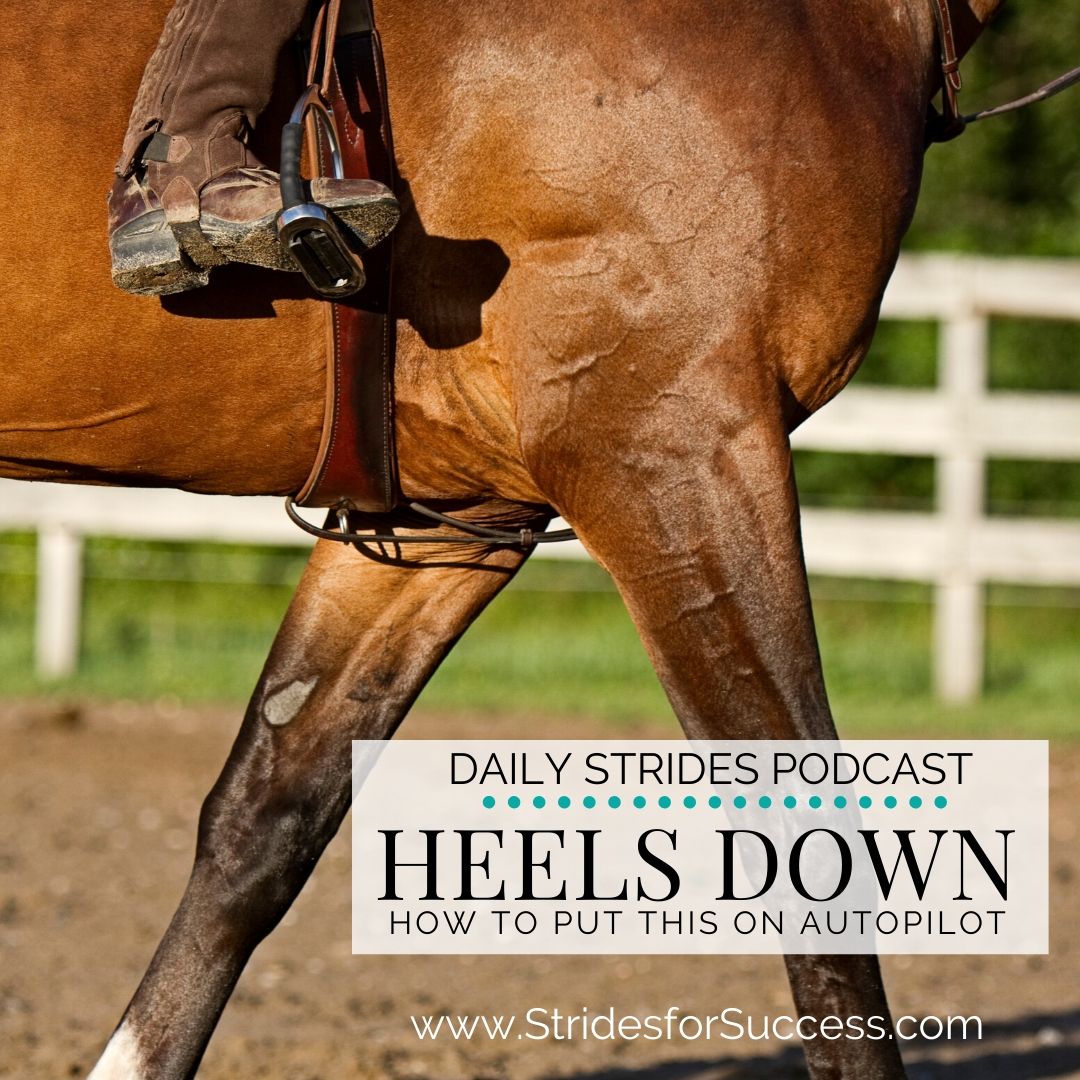
It’s probably one of the first things you were told on your first ride. It is also, for many riders, a misunderstood concept. The truth of ‘heels down’ is that once you can correctly master it, it is an absolute game-changer for everything else in your riding. It is that important.
How much your heel is down will depend on what you are doing at any given time. What doesn’t change is that the weight is dropped into the heel. Always.
It is a pretty easy thing to do. Heels down. And it is also one of the first things you should work on putting onto autopilot in your riding. Meaning that you don’t have to think about it. It just happens by itself.
Having heels down on autopilot will allow you to focus on your actual communication with your horse.
The Weight Drops into Your Heel
Heels down are easily visualized. If someone tells you to put your heels down, you know what they are talking about and what they want you to do. Compare this with ‘allow the weight to drop into your heels’. Come again?! And this is why riding instructors use the term ‘heels down’ when working with novice riders.
However, I want you to begin to understand that it is the weight dropping into your heel that is important. Your heels down is a result of you allowing weight to drop into your heels.
But again, when you are initially starting out on the riding journey, ‘sitting’ in your saddle. Foot firmly in your stirrup due to the level of mental comfort it provides; the question is often “what weight?! I’m sitting down in the saddle!”. As you dive more into your position and posture as a rider, you begin to understand that there is carrying and a draping that happens through your body. A balance between elongating and simply allowing.
The degree of heels down can certainly change. In fact, I can bet that it will depend on the set of circumstances you find yourself in at any given time.
What shouldn’t change is the fact that the weight is dropped into your heels.
The Angle Between Your Foot and Leg
There are lots of different variations of heels down. A dressage rider and an eventer out cross country would (and really should) look a whole lot different where heels down are concerned. The difference comes to down to your ankle joint.
How much weight you allow to drop into your heels will change depending on what you are doing. What does not change is that the heel is weighted.
The easiest way to notice the difference is to look at how parallel the sole of the riders shoe or boot is to the ground. Often you will notice that dressage riders feet are almost parallel. Showjumpers and eventers are not. In fact the angle of the sole of their boot and the ground can vary a lot depending on what they are doing at any given point in the ride. It is ever-changing.
And this is why your ankle joint is so important. It is one of your ‘shock absorbers’ when you ride. And how much flexion is happening in the joint depends a lot on how your foot is placed in the stirrup.
Placement of Foot in the Stirrup
Next time you ride, have a look at the angle and relationship between the stirrup iron and your foot. So many novice riders ‘fix’ their irons, so that it is at an exact right angle to their foot. It goes directly across the foot, if viewed from above (or in the saddle). This limits the flexion of your ankle joint.
The stirrup iron should rather be angled at about 45 degrees across your foot. From the ball of your foot to the toenail of your little toe is a good visual indicator.
Put another way, the ‘outside’ of the iron is more forward than the inside. Test it out in halt. Play with the angle between your iron and your foot. Then, in the halt, stand up and down or transition in and out of light seat a few times. Notice how your ankle joint is more supple when the iron is angled, versus the iron being ‘straight’ across your foot.
Your Lower Leg
If you do take me up on this and practice it, you can also begin to notice your lower leg and what it wants to do when you do ‘put weight into your heel’. Ideally, you want your lower leg underneath you. I know, it begs the question “where else would it be?”, but you would be surprised! Many riders ride with their lower leg either too far forward or too far back.
A forward lower leg is great when you need to ride a little defensively. However, if it is your ‘normal’, your lower leg cannot be an effective aid in your communication with your horse.
And yet, for many riders, as soon as they ‘push their heels down’ the lower leg shoots forward. So forward that they ride from the elbow or shoulder of the horse! This is something that must be worked on. Again, I suggest beginning in the halt and moving between sitting and rising. Like you were posting in the trot.
The goal is to allow the weight to drop into your heel (stand on your heel) without your lower leg budging. No movement. Staying exactly where it should be; underneath you.
Working on this is where you begin developing a ‘secure lower leg’. A vitally important part of becoming an effective communicator when in the saddle and riding.
Practice, Practice, Practice…
In order for you to successfully get this part of your riding onto autopilot, you need to practice. Consistent attention to your foot, your ankle, and your lower leg. Begin working between walk and halt. Then build to trot. As you drop the weight into your heel, work on controlling your lower leg.
Notice how it feels to weight your heel and then engage your lower leg in order to keep it still. No squeezing or gripping. Simply an ‘engagement’. A mindful intention.
An easy way of seeing if your lower leg is ‘shooting forward’ or not is to glance down. You should just be able to see your tippy-toes peeping out from below your knee as you ride. Any more of your foot or your stirrup iron and your lower leg is probably too far forward. No toes? Your lower leg is probably too far back.
This is something that, if you’re struggling with balance, confidence, or just plain old falling off, will change EVERYTHING in your riding. It is that powerful.
Happy riding
Lorna
Additional Resources on this Topic:-
- Applying the ‘Click Your Fingers Rule’ to Your Riding
- Position Faults that Are Potentially Holding You Back In Your Riding
- Identifying Causes Versus Symptoms in Your Riding
- Join the free Facebook group HERE
- The Daily Strides Podcast on iTunes
- Daily Strides Podcast on Google Play
- The Daily Strides Podcast on Stitcher Radio
- Join Daily Strides Premium

